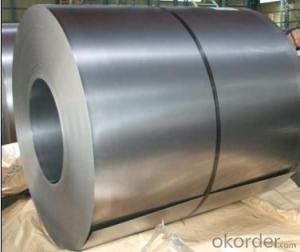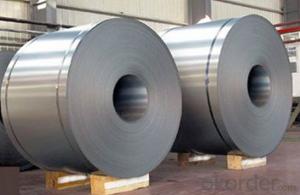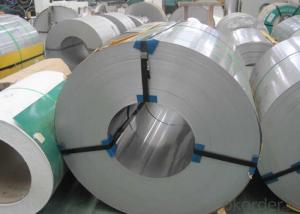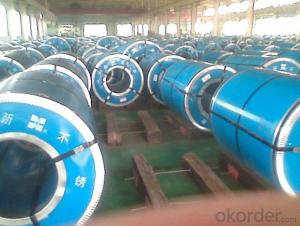Stainless Steel Coil 304 Surface Finish No.1
- Loading Port:
- Guangzhou
- Payment Terms:
- TT OR LC
- Min Order Qty:
- 100 m.t.
- Supply Capability:
- 8000 m.t./month
OKorder Service Pledge
OKorder Financial Service
You Might Also Like
Grade: | 300 Series | Standard: | JIS,AISI,ASTM,GB,DIN,EN etc | Thickness: | 2.5mm, 3.0mm, 4.0mm |
Width: | 550mm-1500mm | Length: | according to weight | Place of Origin: | China (Mainland) |
Brand Name: | CNBM | Model Number: | 304 | Technique: | Hot Rolled |
Application: | industry, construction, furniture, repairing | Certification: | MTC | Finishing: | NO.1 |
Market: | globle area | Packaged: | wooden and bags in cases as standard | Payment: | TT & LC |
Delivery time: | 15 days | MOQ: | 100 tons | Advantage: | prime quality, competitive price |
Profession: | hot rolled | Charactor: | stainless steel coils | Material/Grade: | 304 |
Hot Rolled Stainless Steel Coil 304 Annealing and Pickling No.1 Finish
Stainless steel is a production which not easy rust,acid resistance and corrosion resistance,so it is widely
used in light industry,heavy industry,daily necessities and the decoration industry.
Hot Rolled Stainless Steel Coil 304 Specifications
1.surface:NO.1
2.standard:JIS, AISI, GB
3.width: 0.55m, 0.65m, 1.0m, 1.22m, 1.5m, 2m or requirement
Hot Rolled Stainless Steel Coil 304 Chemical Composition:
(%):C=0.07, Mn=2.00, P=0.045, S=0.030, Si=0.075, Cr=17.5-19.5, Ni=8.0-10.5, N=0.10
Hot Rolled Stainless Steel Coil 304 Physical Properties
Tensile strength σb (MPa) ≥ 520
the conditions yield strength σ0.2 (MPa) ≥ 205,
elongation δ5 (%) ≥ 40
Reduction of ψ (%) ≥ 50,
hardness: ≤ 187
HB; ≤ 90
HRB; ≤ 200H
Type | Hot Rolled Stainless Steel Coil 304 |
Thickness | 3.0mm-4.0mm |
Width | 550mm, 650mm, 1000mm, 1219mm, 1240mm, 1500mm |
Length | according to weight |
Brand name | CNBM |
Standard | ASTM, AISI, DIN, GB, JIS etc |
Material | 304 |
Application | Foodstuff, Gas, metallurgy, biology, electron, chemical, petroleum, boiler, nuclear energy, Medical equipment, fertilizer etc |
Package | Standard export sea-worthy packing |
Delivery time | Within 15 days since getting the deposit or LC origin |
Surface | NO.1 |
Productivity | 20000 tons/month |
- Q:Can stainless steel strips be used for jewelry findings?
- Jewelry findings can indeed utilize stainless steel strips. The widespread preference for stainless steel as a jewelry finding can be attributed to its durability, resistance to corrosion, and affordability. It proves to be a suitable material for various kinds of jewelry findings, including clasps, jump rings, chain links, and earring hooks. Stainless steel strips can be effortlessly manipulated, cut, and polished to produce diverse jewelry components. Additionally, they are accessible in multiple finishes, such as polished, brushed, or matte, thereby offering an extensive array of options for jewelry makers. Moreover, stainless steel jewelry findings are hypoallergenic, rendering them appropriate for individuals with sensitive skin or allergies to other metals. All in all, stainless steel strips represent a versatile and pragmatic choice for jewelry findings.
- Q:What is the impact resistance of stainless steel strips?
- Stainless steel strips have excellent impact resistance due to their inherent properties and unique manufacturing process. The impact resistance of stainless steel strips is primarily attributed to their high tensile strength and toughness. Stainless steel is an alloy composed of iron, chromium, and other elements such as nickel, molybdenum, and manganese. These elements provide stainless steel with enhanced mechanical properties, including high strength and ductility. These properties allow stainless steel strips to withstand external forces and impacts without deforming or breaking easily. Moreover, stainless steel strips undergo a process called cold rolling during their manufacturing. Cold rolling involves passing the stainless steel through a series of rollers at a low temperature, which increases its strength and hardness. This process further enhances the impact resistance of stainless steel strips. The impact resistance of stainless steel strips makes them suitable for various applications that require durability and resistance to external forces. They are commonly used in industries such as automotive, construction, aerospace, and marine, where they are exposed to harsh conditions and potential impacts. In conclusion, stainless steel strips exhibit excellent impact resistance due to their high tensile strength, toughness, and the cold rolling process they undergo during manufacture. These properties make stainless steel strips a reliable choice for applications that require resistance to external forces and impacts.
- Q:What are the common thicknesses available for stainless steel strips?
- The common thicknesses available for stainless steel strips range from 0.1mm to 6.0mm.
- Q:What are the different surface finishes for stainless steel strips?
- Stainless steel strips come in various surface finishes, each with its own distinct characteristics and appearances. Let's explore some of the most commonly used finishes: 1. No.1 Finish: The most widely used and basic finish for stainless steel strips, it has a rough, dull appearance with visible grinding marks. No.1 finish is often employed in industrial components or structural parts where aesthetics are not a priority. 2. 2B Finish: This finish boasts a smooth, reflective surface with a moderate level of gloss. It is achieved through a cold-rolling process, followed by annealing and descaling. 2B finish is commonly sought after for applications that require a smooth and even surface, like kitchen appliances, architecture, and automotive trim. 3. No.4 Finish: Also known as brushed or satin finish, this treatment creates a soft, linear grain pattern on the stainless steel strip. It is achieved by polishing the strip with abrasive belts or brushes. No.4 finish finds its place in decorative applications such as furniture, handrails, and signage. 4. BA Finish: BA stands for Bright Annealed, and this finish provides a highly reflective, mirror-like surface. It is achieved by annealing the stainless steel strip in a controlled atmosphere, followed by a final polishing process. BA finish is commonly used for decorative purposes in architectural features, jewelry, and luxury consumer goods. 5. Electropolished Finish: This specialized treatment involves immersing the stainless steel strip in an electrolyte solution and applying an electric current. Electropolishing removes a thin layer of material, leaving behind a smooth, shiny surface with enhanced corrosion resistance. This finish is often utilized in applications where hygiene and cleanability are crucial, such as pharmaceutical equipment, food processing, and medical devices. These examples merely scratch the surface of the numerous surface finishes available for stainless steel strips. The choice of finish is dependent on the specific requirements of the application, encompassing aesthetics, functionality, and corrosion resistance.
- Q:Can stainless steel strips be used in automotive applications?
- Yes, stainless steel strips can be used in automotive applications. Stainless steel is known for its corrosion resistance, durability, and strength, making it an ideal material for various automotive components. It is commonly used in the manufacturing of exhaust systems, fuel tanks, body panels, trim, and other structural components. Stainless steel strips can be formed, welded, and fabricated into different shapes and sizes, providing versatility and flexibility in automotive design. Additionally, stainless steel's aesthetic appeal and ability to maintain its appearance over time make it a popular choice for automotive applications.
- Q:What are the different types of surface finishes for stainless steel strips?
- There are several different types of surface finishes that are commonly used for stainless steel strips. These finishes are applied to the surface of the stainless steel in order to improve its appearance, increase its corrosion resistance, and enhance its durability. 1. Mill Finish: This is the most basic type of surface finish, which is achieved by leaving the stainless steel strip in its original, as-produced state. It has a dull, non-reflective appearance and may have visible imperfections or marks from the manufacturing process. 2. No. 1 Finish: Also known as hot-rolled annealed and pickled (HRAP), this finish is achieved by annealing the stainless steel strip and then pickling it in acid. It has a smooth, reflective surface with a slightly matte appearance. No. 1 finish is commonly used in industrial applications where surface appearance is not a primary concern. 3. No. 2B Finish: This finish is achieved by cold-rolling the stainless steel strip and then annealing and pickling it. It has a smooth, reflective surface with a bright, semi-reflective appearance. No. 2B finish is commonly used in applications that require a good balance between appearance and corrosion resistance, such as kitchen appliances and architectural elements. 4. No. 4 Finish: Also known as brushed or satin finish, this finish is achieved by mechanically polishing the stainless steel strip with abrasive materials. It has a smooth, matte appearance with fine parallel lines, giving it a brushed texture. No. 4 finish is commonly used in decorative applications, such as furniture, elevator panels, and decorative trims. 5. No. 8 Finish: Also known as mirror finish, this finish is achieved by polishing the stainless steel strip to a highly reflective surface. It has a mirror-like appearance with excellent reflectivity. No. 8 finish is commonly used in architectural and decorative applications that require a high-end, polished look, such as signage, jewelry, and automotive trims. In addition to these main surface finishes, there are also other specialized finishes available for specific applications, such as embossed finishes, patterned finishes, and colored finishes. These finishes further enhance the aesthetic appeal and functionality of stainless steel strips in various industries.
- Q:What is the conductivity of stainless steel strips?
- Stainless steel strips have relatively low electrical conductivity compared to other metals due to their high resistance to electrical flow.
- Q:Can stainless steel strips be used in the food processing equipment industry?
- Yes, stainless steel strips can be used in the food processing equipment industry. Stainless steel is a popular material choice in the food processing industry due to its many beneficial properties. It is corrosion-resistant, which is essential in an environment where food and liquids are present. Stainless steel is also hygienic and easy to clean, making it suitable for equipment that comes into contact with food. Additionally, stainless steel has high strength and durability, ensuring that the equipment can withstand the rigorous demands of the food processing industry. Therefore, stainless steel strips are commonly used in the manufacturing of food processing equipment such as conveyors, mixers, slicing machines, and food storage containers.
- Q:Can 111 stainless steel strips be used in geothermal power plants?
- Yes, 111 stainless steel strips can be used in geothermal power plants. Stainless steel is often used in such plants due to its high corrosion resistance and ability to withstand high temperatures and pressure, making it suitable for various components and equipment within the geothermal power generation process.
- Q:What are the dimensions of stainless steel strips?
- The specific needs and requirements of the application determine the dimensions of stainless steel strips, which can vary. However, these strips are typically found in different thicknesses, ranging from 0.1mm to 6mm, and various widths, ranging from 10mm to 2000mm. The length of stainless steel strips can also vary, although it is commonly sold in coils or rolls of standard lengths like 1000mm or 2000mm. Furthermore, stainless steel strips can be tailor-made to fit individual project requirements by cutting them to specific dimensions.
1. Manufacturer Overview |
|
|---|---|
| Location | |
| Year Established | |
| Annual Output Value | |
| Main Markets | |
| Company Certifications | |
2. Manufacturer Certificates |
|
|---|---|
| a) Certification Name | |
| Range | |
| Reference | |
| Validity Period | |
3. Manufacturer Capability |
|
|---|---|
| a)Trade Capacity | |
| Nearest Port | |
| Export Percentage | |
| No.of Employees in Trade Department | |
| Language Spoken: | |
| b)Factory Information | |
| Factory Size: | |
| No. of Production Lines | |
| Contract Manufacturing | |
| Product Price Range | |
Send your message to us
Stainless Steel Coil 304 Surface Finish No.1
- Loading Port:
- Guangzhou
- Payment Terms:
- TT OR LC
- Min Order Qty:
- 100 m.t.
- Supply Capability:
- 8000 m.t./month
OKorder Service Pledge
OKorder Financial Service
Similar products
New products
Hot products
Hot Searches
Related keywords




























